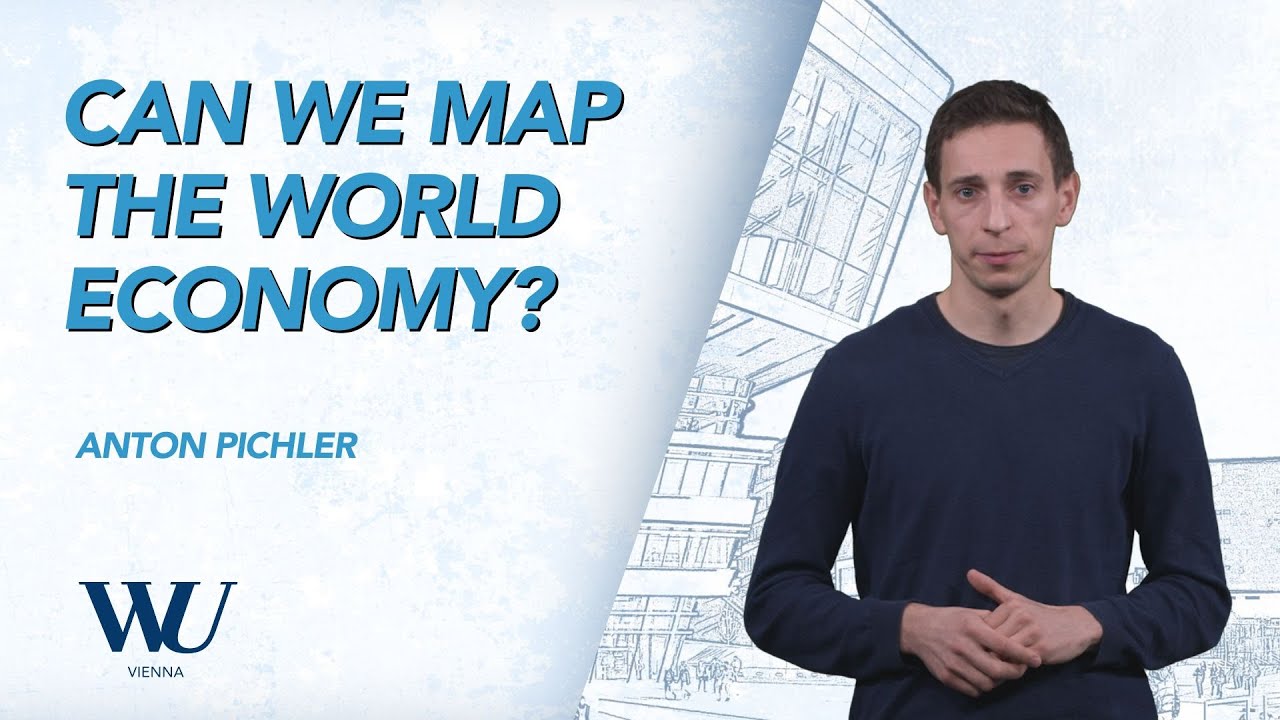Anton Pichler
Is it possible to map the entire global economy with all its supply chains? Anton Pichler from the WU Institute of Transport Economics and Logistics says yes. Together with researchers from all over the world, he has launched an initiative to do just that – and make our economy more robust and sustainable in the process.

The challenges of mapping global…
During crises such as the recent Covid pandemic, it becomes apparent just how interconnected our global economy is and how quickly it can get out of whack. The shortages in medical equipment such as ventilators and oxygen tanks are a clear case in point.
Behind each of these products lies a complex network of supply chains. Numerous companies are involved in the delivery of a medical ventilator to a hospital. This includes manufacturers and wholesalers, but also suppliers of raw materials and packaging, logistics and carrier companies, and other players. In our modern economy, these companies are often spread all over the world. If some of the critical links break down, this can result in a shortage of important medical supplies.
In his research, Anton Pichler from WU Vienna’s Institute for Transport and Logistics Management looks at the interconnectedness of the global economy and its underlying supply chain links. The overall goal of his work is to create a comprehensive map of the global flows of money and goods. Such a world map would give us valuable insights into how the global economy works, and it would help us to make the world economy fairer, more resilient, and more sustainable.
In the latest episode of Meet Our Researchers, Anton Pichler explains how digitalization and big data are opening up completely new methodological approaches for mapping our economy. We met Anton Pichler at his office for an interview, and we asked him how he got involved in a global research initiative that is working to figure out ways of creating such a map.
![[Translate to English:] Foto von Anton Pichler in Gebäude D1](/fileadmin/wu/_processed_/c/3/csm_antonpichler1_3c94ce528a.jpg)
Anton Pichler on the premises of the Institute of Transport Economics and Logistics in building D1: “I am lucky to be part of a great team where everyone supports each other and where we have a pleasant workplace atmosphere.”
As a researcher, it's not exactly an everyday occurence to publish an internationally recognized policy brief in the scientific journal Science. How did this come about?
Essentially, I was involved in various research teams working on the development of granular economic models that represented individual firms. The aim of this type of work is to develop an approach that can track heterogeneous macroeconomic effects better than aggregate models. To develop such fine-grained models, however, we need better data at the company level and better data about the underlying supply chain structure. This kind of data is available for some countries, and on this basis, we’ve been able to deliver a proof of principle that illustrates the potential of these approaches.
To help strengthen the exchange of ideas and collaboration in this research community, I started to co-organize workshops on corporate production networks a few years ago. These events are intended to present the latest developments with regard to data and models. After three editions of this workshop held in Vienna and one held in Cambridge, the fifth will take place in Oxford this year. It’s clear to see that this young field is developing rapidly and that a larger research agenda is emerging.
What has the response been like?
In our article, we emphasize the important role that politics could play in this context. In some countries, for example, more efficient tax collection processes have been introduced, resulting in much better data and tax discipline. One of our goals with this article was to raise awareness of these positive effects. Since then, a number of collaborations have formed, and various research institutes have built up networks and joined forces. Representatives from various governments’ statistical authorities have attended our workshops, and several cross-border projects have been launched.
Since publishing the article, we’ve received a number of invitations to explain the relevance of this topic in different contexts and on various occasions. For example, we provided an in-depth look at the benefits this approach has for central banks and monetary policy in a SUERF policy brief. For Think20, an official engagement group of the G20, we outlined how better granular data can help us gain a fuller understanding of the impacts of climate change.
In general, there’s a lot going on in this area. Organizations such as the OECD have launched initiatives of their own, and the research area as a whole is expanding. We’re working to bring all these groups together because they’re doing important basic research that offers great potential for developing better models going forward.
![[Translate to English:] Foto von Anton Pichler vor seinem Whiteboard](/fileadmin/wu/_processed_/f/0/csm_antonpichler3_c0350f891b.jpg)
At home in the world of data: Anton Pichler studied Quantitative Science at WU and then completed a PhD in Mathematics at the University of Oxford.
In your research, you mostly focus on supply chains. What fascinates you about this topic?
For me, analyzing these complex company networks is very much like mapping uncharted territory – it’s all about creating a sort of map of the global economy. Companies are interacting with each other, and this creates a network structure that allows us to gain a deeper understanding of the flows of goods and money.
I see these network structures as a central building block for understanding how interactions at the local level lead to different macroeconomic effects, which in turn influence decisions at the micro level. In this way, supply chains offer valuable insights that help us to better understand how the economy works.
I think there are some similarities to other disciplines. In biology, for example, researchers use microscopes to visualize molecules and their interactions, which helps them to decipher the intrinsic mechanisms and the evolution of entire organisms. Similarly, a more fine-grained picture of local interactions between companies will contribute to a better understanding of higher-level economic dynamics.
How long have you been at WU?
I first came to WU as a student. It’s here that I completed my master’s degree in quantitative finance, which was an ideal preparation for my subsequent PhD studies in mathematics at Oxford University. After spending four years at Oxford, I returned to Vienna to join the Complexity Science Hub with a James S. McDonnell Fellowship. In the fall of 2023, I joined WU’s Institute of Transport and Logistics Management, where I work in the field of supply chain analytics.
![[Translate to English:] Portraitbild von Anton Pichler](/fileadmin/wu/_processed_/4/4/csm_antonpichler2_caacd7c4f2.jpg)
Recharging on the terrace of office building D1: “The sunsets are wonderful here.”
What do you like about WU as a workplace?
The infrastructure we have available here is first class, and Campus WU is one of the best university campuses in the world. I’m also lucky to be part of a great team where everyone supports each other and where we have a pleasant workplace atmosphere.
Do you have a favorite place on Campus WU?
Unfortunately, I don't have enough time to enjoy the many beautiful spots at WU because of my busy schedule. But I have to say that I do like the big balcony in our office building, the D1 building. The sunsets are wonderful there.
